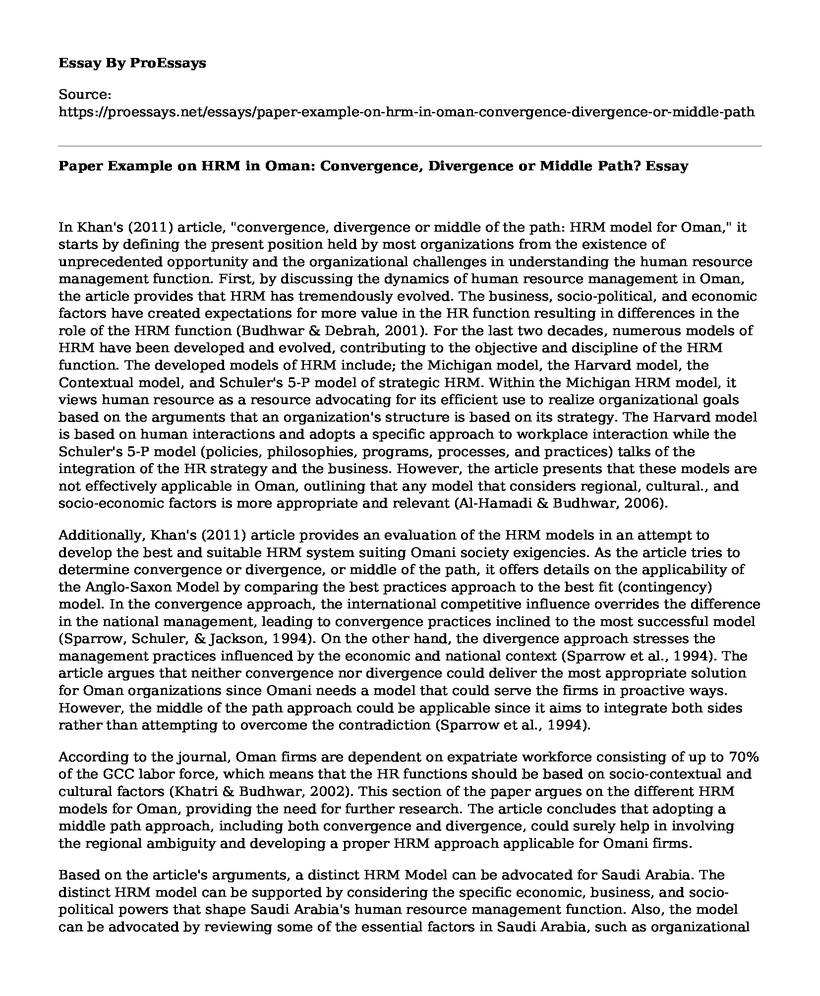In Khan's (2011) article, "convergence, divergence or middle of the path: HRM model for Oman," it starts by defining the present position held by most organizations from the existence of unprecedented opportunity and the organizational challenges in understanding the human resource management function. First, by discussing the dynamics of human resource management in Oman, the article provides that HRM has tremendously evolved. The business, socio-political, and economic factors have created expectations for more value in the HR function resulting in differences in the role of the HRM function (Budhwar & Debrah, 2001). For the last two decades, numerous models of HRM have been developed and evolved, contributing to the objective and discipline of the HRM function. The developed models of HRM include; the Michigan model, the Harvard model, the Contextual model, and Schuler's 5-P model of strategic HRM. Within the Michigan HRM model, it views human resource as a resource advocating for its efficient use to realize organizational goals based on the arguments that an organization's structure is based on its strategy. The Harvard model is based on human interactions and adopts a specific approach to workplace interaction while the Schuler's 5-P model (policies, philosophies, programs, processes, and practices) talks of the integration of the HR strategy and the business. However, the article presents that these models are not effectively applicable in Oman, outlining that any model that considers regional, cultural., and socio-economic factors is more appropriate and relevant (Al-Hamadi & Budhwar, 2006).
Additionally, Khan's (2011) article provides an evaluation of the HRM models in an attempt to develop the best and suitable HRM system suiting Omani society exigencies. As the article tries to determine convergence or divergence, or middle of the path, it offers details on the applicability of the Anglo-Saxon Model by comparing the best practices approach to the best fit (contingency) model. In the convergence approach, the international competitive influence overrides the difference in the national management, leading to convergence practices inclined to the most successful model (Sparrow, Schuler, & Jackson, 1994). On the other hand, the divergence approach stresses the management practices influenced by the economic and national context (Sparrow et al., 1994). The article argues that neither convergence nor divergence could deliver the most appropriate solution for Oman organizations since Omani needs a model that could serve the firms in proactive ways. However, the middle of the path approach could be applicable since it aims to integrate both sides rather than attempting to overcome the contradiction (Sparrow et al., 1994).
According to the journal, Oman firms are dependent on expatriate workforce consisting of up to 70% of the GCC labor force, which means that the HR functions should be based on socio-contextual and cultural factors (Khatri & Budhwar, 2002). This section of the paper argues on the different HRM models for Oman, providing the need for further research. The article concludes that adopting a middle path approach, including both convergence and divergence, could surely help in involving the regional ambiguity and developing a proper HRM approach applicable for Omani firms.
Based on the article's arguments, a distinct HRM Model can be advocated for Saudi Arabia. The distinct HRM model can be supported by considering the specific economic, business, and socio-political powers that shape Saudi Arabia's human resource management function. Also, the model can be advocated by reviewing some of the essential factors in Saudi Arabia, such as organizational culture, the influence of the expatriate workforce, and the management model unique to Saudi Arabia firms. Correspondingly, a distinct model for Saudi Arabia can be advocated since the HR functions in nations are different from each other and increase the applicability of the use of the HRM function towards achieving organizational excellence and performance.
References
Al-Hamadi, A. & Budhwar, P. (2006). Human Resource Management in Oman. In Budhwar, P. & Mellahi, K. (Eds.). Managing Human Resource in the Middle East. London: Routledge, pp. 40-58. doi:10.4337/9781784719524
Budhwar, P. & Debrah, Y. (2001). Rethinking comparative and cross-national human resource management. International Journal of Human Resource Management. 12(3), 497-515. doi:10.1080/713769629
Khan, S. A. (2011). Convergence, divergence, or middle of the path: HRM model for Oman. Journal of Management policy and practice, 12(1), 76-87.
Khatri, N., & Budhwar, P. S. (2002). A study of strategic HR issues in an Asian context. Personnel Review, 31(2), 166-188. doi:10.1108/00483480210416856
Sparrow, P.R. Schuler, R.S. & Jackson, S. E. (1994). Convergence or divergence: human resource practices and policies for competitive advantage worldwide. International Journal of Human Resource Management, 5(2), 267-299. Doi:10.1080/09585199400000019
Cite this page
Paper Example on HRM in Oman: Convergence, Divergence or Middle Path?. (2023, Mar 13). Retrieved from https://proessays.net/essays/paper-example-on-hrm-in-oman-convergence-divergence-or-middle-path
If you are the original author of this essay and no longer wish to have it published on the ProEssays website, please click below to request its removal:
- The Importance of Conducting Appraisals and Rewarding Employee Performance
- Paper Example on Transport Industry: An Understanding of the Industry and What I Have Learned
- Reasons for Banning Energy Drinks Essay Example
- The Characteristics of Expert Teachers Paper Example
- Essay Sample on Corporate Social Responsibility: 4 Features & Benefits of Corporate Social Responsibility
- Specializing in Psychology: Key to Successful Career - Essay Sample
- Paper Example on DRA PS-Human Resources Management







